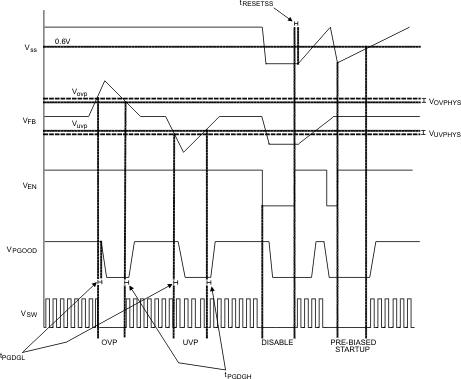SNOSB87D March 2011 – May 2019 LM21215A
PRODUCTION DATA.
- 1 Features
- 2 Applications
- 3 Description
- 4 Revision History
- 5 Pin Configuration and Functions
- 6 Specifications
- 7 Detailed Description
- 8 Application and Implementation
- 9 Power Supply Recommendations
- 10Layout
- 11Device and Documentation Support
- 12Mechanical, Packaging, and Orderable Information
Package Options
Mechanical Data (Package|Pins)
- PWP|20
Thermal pad, mechanical data (Package|Pins)
- PWP|20
Orderable Information
7.3.4 PGOOD Indicator
The PGOOD flag provides the user with a way to monitor the status of the LM21215A. In order to use the PGOOD function, the application must provide a pullup resistor to a desired DC voltage, for example VIN. PGOOD responds to a fault condition by pulling PGOOD low with the open-drain output. PGOOD pulls low on the following conditions: 1) VFB moves above or below the VOVP or VUVP, respectively; 2) The EN voltage is brought below the Enable turn-off threshold; 3) A pre-biased output condition exists (VFB > VSS/TRK). PGOOD has 12 μs and 15 μs of built-in deglitch time for rising and falling edges, respectively.
Figure 24 shows the conditions that cause PGOOD to respond.
 Figure 24. PGOOD Indicator Operation
Figure 24. PGOOD Indicator Operation